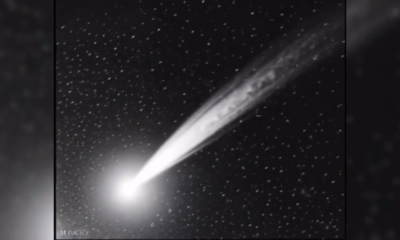Science
Scientists Excited as Comet 3I/Atlas Approaches Our Solar System

A comet named 3I/Atlas is currently traveling through our solar system, having been first detected in July 2023. This interstellar visitor is moving at an impressive speed of approximately 61 kilometers (38 miles) per second and is only the third known interstellar object observed, following the discoveries of ‘Oumuamua in 2017 and 2I/Borisov in 2019. The excitement among scientists has intensified after the Hubble Space Telescope captured images of this celestial body, providing a unique opportunity to study its size and chemical composition.
Researchers are particularly intrigued by 3I/Atlas because it presents a chance to examine an object originating from beyond our solar system. Dr. Rebecca Allen, co-director of Swinburne’s Space Technology and Industry Institute, stated, “We’ve never had an object like this to study before.” Meanwhile, Dr. Laura Driessen, a radio astronomer at the University of Sydney, explained that while the exact origin of 3I/Atlas remains unknown, it is confirmed to have come from outside our solar system.
The name 3I/Atlas incorporates the letter “i” for interstellar, the number “3” indicating it as the third such object detected, and “Atlas” referring to the network of telescopes, known as the Asteroid Terrestrial-impact Last Alert System, responsible for its identification. Although some have speculated about the possibility of extraterrestrial origins, scientists believe 3I/Atlas is most likely a comet. Driessen remarked, “There’s no evidence to point towards [3I/Atlas] being anything other than a really fun space rock that came from outside the solar system. Which, to be honest, is cool enough.”
Characteristics and Trajectory of 3I/Atlas
In the images captured by Hubble, 3I/Atlas appears somewhat like a “fuzzy snowball.” This hazy look results from its coma, which forms as the comet’s surface heats up due to the sun’s proximity, releasing dust and gas. As it approaches the sun, more signs of a comet tail are expected to become visible, and researchers will utilize a method known as spectroscopy to analyze the light emitted, allowing them to identify the comet’s material composition.
The estimated diameter of 3I/Atlas ranges from less than 5.6 kilometers to potentially as small as 320 meters. Its trajectory is particularly noteworthy; traveling at over 200,000 kilometers per hour, it will pass through the inner solar system, moving between the orbits of Mars and Earth before flying past the sun. According to Allen, “This one is on what we call a hyperbolic orbit. So it’s not gravitationally bound to the sun. It’s traveling much too fast, and so it will just fly out the other side of the solar system.”
The comet is expected to make its closest approach to the sun between October and December 2023, coming within approximately 210 million kilometers of the sun. Its closest distance to Earth will be around 270 million kilometers. Con Stoitsis, the comet and meteor director at the Astronomical Society of Victoria, noted that the exact endpoint of its journey will remain unclear until it passes the sun and starts heading back into the outer solar system.
Viewing Opportunities for 3I/Atlas
At present, 3I/Atlas is faint, but as it nears the sun, it is anticipated to brighten, potentially becoming visible through larger amateur telescopes. Stoitsis suggested that while it may become accessible to enthusiasts, it will likely still appear as a smudge rather than a clearly defined object. He commented, “We get bright-ish comets, three or four times a year, which are visible with small telescopes and binoculars. This is definitely not one of those. Unless you’ve got a decent-sized telescope, you won’t see it.”
As the scientific community continues to observe and analyze 3I/Atlas, its interstellar origins and the data gathered from its passage through our solar system will contribute to our understanding of cometary bodies and the conditions that exist beyond our own solar neighborhood.
-

 World3 days ago
World3 days agoCoronation Street’s Shocking Murder Twist Reveals Family Secrets
-

 Entertainment4 months ago
Entertainment4 months agoKate Garraway Sells £2 Million Home Amid Financial Struggles
-

 Entertainment3 months ago
Entertainment3 months agoAnn Ming Reflects on ITV’s ‘I Fought the Law’ Drama
-

 Health3 months ago
Health3 months agoKatie Price Faces New Health Concerns After Cancer Symptoms Resurface
-

 Entertainment3 weeks ago
Entertainment3 weeks agoCoronation Street Fans React as Todd Faces Heartbreaking Choice
-

 World4 weeks ago
World4 weeks agoBailey Announces Heartbreaking Split from Rebecca After Reunion
-

 Entertainment6 days ago
Entertainment6 days agoTwo Stars Evicted from I’m A Celebrity Just Days Before Finale
-

 World6 days ago
World6 days agoKevin Sinfield Exceeds Fundraising Goal Ahead of Final Marathons
-

 Entertainment3 months ago
Entertainment3 months agoCoronation Street’s Carl Webster Faces Trouble with New Affairs
-

 Entertainment3 months ago
Entertainment3 months agoWhere is Tinder Swindler Simon Leviev? Latest Updates Revealed
-

 Entertainment4 months ago
Entertainment4 months agoMarkiplier Addresses AI Controversy During Livestream Response
-

 Science2 months ago
Science2 months agoBrian Cox Addresses Claims of Alien Probe in 3I/ATLAS Discovery





















